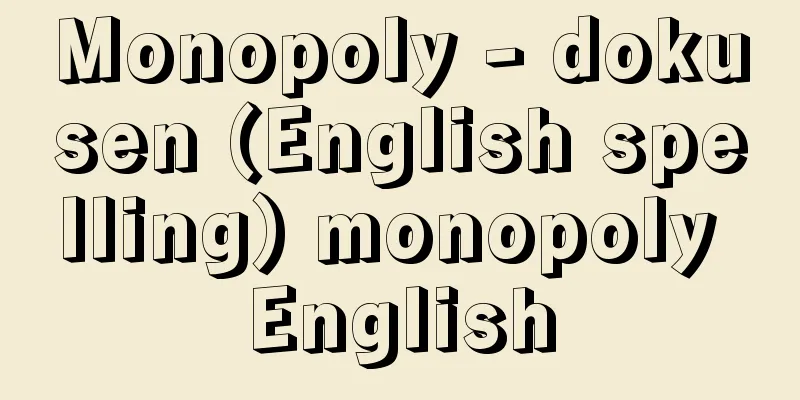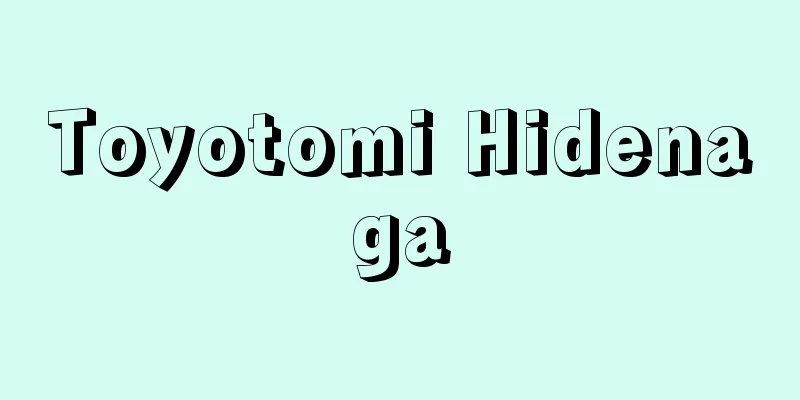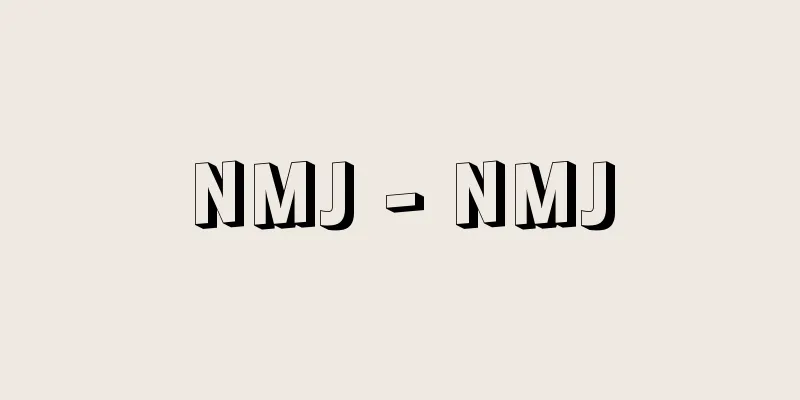Monopoly - dokusen (English spelling) monopoly English

|
As the word monopoly's origins in the Greek word meaning "sole seller" make clear, it refers to a state in which a company (or group of companies) has exclusive control over a market or industry. [Toshiyuki Uchijima] Monopoly from the Perspective of Modern EconomicsIn modern economics, monopolies are primarily analyzed from a functional perspective. When there is one seller, it is called a seller (supply) monopoly, when there is one buyer, it is called a buyer (demand) monopoly, and when there is both one seller and one buyer, it is called a dual monopoly. However, when modern economics talks about monopoly, it is best to think of it as referring to a seller monopoly. There are three reasons why monopolies exist: (1) Because of economies of scale, it is cheaper to produce something by one company than by many companies. This applies to public utilities such as electricity, gas, railroads, telephones, and airlines. When a monopoly is formed due to economies of scale, it is called a natural monopoly. (2) A monopoly exists because one firm has complete control over a scarce resource, which can include natural resources such as mines, hot springs, other raw materials, or even knowledge such as patents. (3) A monopoly exists because the right to be the sole seller of a product is granted in the form of a license to a state or a company. Tobacco is an example of this because it remains a monopoly, even though it was privatized from a public tobacco monopoly. [Toshiyuki Uchijima] Pricing by a MonopolistAs shown in (1), the demand curve DD for a monopoly with complete monopoly power slopes downward to the right. A monopoly firm aiming to maximize profits will choose the production volume Qm where marginal revenue MR is equal to marginal cost MC . In response, the price is determined to be Pm . Sales revenue, which is the product of price and production volume, is OPm MQm . When the average cost curve is AC , production costs, which are the product of production volume and average cost, are OGFQm . The difference between sales revenue and production costs is Pm MFG , which represents the profits of the monopoly firm. If the demand conditions and cost (technology) conditions do not change, there is no possibility of new entrants, so the monopoly firm can continue to enjoy this profit. Now, if we assume that this industry is perfectly competitive, the supply curve for a perfectly competitive industry is the marginal cost curve MC . In this case, price equals marginal cost, so the perfectly competitive solution is shown by point C , with price P c and output Q c . Comparing point C with point M , the monopoly solution, we can see that in the case of a monopoly, the price is high and the output level is low. From the perspective of society as a whole, the desirable output level is Q c , but under a monopoly only Q m is produced. Therefore, facilities sufficient to accommodate the difference between Q c and Q m are not being used, and excess production capacity exists under a monopoly. Resources are not being allocated efficiently. [Toshiyuki Uchijima] Natural monopolyLet us look at why the existence of economies of scale leads to monopoly rather than perfect competition ( (2)). Economies of scale mean that the average cost curve AC slopes downwards; that is, the more you produce, the cheaper the cost per unit. In this case, the marginal cost curve MC is always below the average cost curve AC . The monopoly solution is point M , with price Pm , output Qm , and profits shown in light red. Can the intersection C of the marginal cost curve MC and the demand curve DD be considered a perfectly competitive solution? At point C , the price is CQc and the average cost is GQc . Average cost exceeds price by GC . This means that a perfectly competitive firm will always be in the red. A firm that operates according to the price equals marginal cost rule cannot make a positive profit, so point C cannot be considered a perfectly competitive solution. In an economy where economies of scale are at work, perfect competition is not achieved and monopolies exist. However, the socially desirable output is Q c , which corresponds to point C. The monopoly produces only Q m , which is too small from a social point of view. The government may regulate the monopoly to produce Q c . If it operates at point C , the monopoly will suffer a loss of GC per unit of output, so the government can cover this loss with a subsidy. This type of regulation of natural monopolies is often seen in the railroad industry, and is based on the "marginal cost pricing principle." The other type is based on the "average cost pricing principle." This regulates the price P b to be equal to the average cost, and the monopoly chooses the output Q b , which corresponds to point B (the intersection of the demand curve and the average cost curve). In this case, monopoly profits are zero. The output of a regulated firm is smaller than the socially desirable output Q c , but larger than the output Q m without regulation. It is often argued that regulation of this type of monopoly, based on easy-to-calculate average costs rather than hard-to-calculate marginal costs, is more rational. [Toshiyuki Uchijima] Monopoly from a Marxian perspectiveIn contrast to modern economics, which fundamentally views the capitalist system as a market economy system, and presents a comparative functional theory of various market forms, Marxian economics, which inherently emphasizes a historical perspective and is characterized by a structural analysis of the economic society, considers "monopoly" from a broader perspective. First, monopolies are seen as something that emerges during a certain historical development of the capitalist market economy. Originally, the capitalist system emerged as a system of market competition for modern industrial capital, which sought to maximize profits through free competition in the market, replacing the privileged commercial capital that was linked to political power in the Middle Ages and early modern times. However, free competition, on the one hand, encouraged the competitive expansion of the scale of individual companies aiming to gain profits (capital accumulation), and on the other hand, encouraged the absorption and merger of weaker companies that lost in the competition (capital concentration), resulting in a high concentration of production and capital in a few large companies (monopoly capital). This is the process known as the development and transformation of capitalism from free competition to the monopoly stage. For example, according to a survey by the Ministry of Finance (now the Ministry of Finance), as of 1996, 5,114 large companies with capital of 1 billion yen or more, which accounted for only 0.21% of the total number of incorporated companies in Japan, accounted for 43.6% of the total assets of all incorporated companies, 63.0% of the capital, 19.8% of the employees, 37.8% of sales, and 56.8% of operating profits. This tendency for economic activity to be highly concentrated in a few large companies is a reality commonly seen in modern advanced capitalist economies. Along with the general concentration of the economy in a few large companies, there is also the concentration of production (shipment concentration) in large companies (groups) in specific industries. According to a survey by the Fair Trade Commission, the simple average of the cumulative shipment concentration rates of the top three companies in each of Japan's major industries in 1994 was highest at 78.8% in the transportation machinery and equipment manufacturing industry, followed by metal products at 69.5%, electrical machinery and equipment at 66.0%, general machinery and equipment at 64.9%, and food at 64.4%, with manufacturing industries generally being about 10 points higher than the average rate of 54.0% for the 34 non-manufacturing industries. Modern monopolies are not limited to the concentration of production and capital in a few large corporations. These large corporations also have numerous subsidiaries and affiliated companies under their umbrella. According to the Ministry of Finance survey mentioned above, the largest 100 corporations (asset concentration rate of 19.4%), which account for only 0.005% of all incorporated companies, own 50% or more of the stocks of 4,075 affiliated companies, and if these affiliated companies are included, the total asset concentration rate is 23.7%. In other words, the economic control of large corporations is also exercised through the exercise of influence over related subsidiaries and affiliated companies across various stages of production and distribution. However, this concentration rate has declined by about 7 percentage points in the 10 years from 1986 to 1996. Now, the above-mentioned monopolistic business combinations are supported not only by the transaction of products and services, but also by financial and personnel connections such as stock issuance, financing, and even mutual dispatch of executives. Historically, the joint stock company system was the most effective means of forming monopolistic giant companies and business combinations. This system mobilized huge amounts of idle capital in society, making it possible to expand the scale of a company beyond the limits of internal funds such as profits, and on the other hand, the decentralization of stock ownership made it possible for a small number of stock owners to control other companies (this is called concentration of control). The influence of giant banks, which are responsible for the social mobilization of funds and stock issuance, also increased. The German Social Democratic Party theorist R. Hilferding once called "capital managed by banks and used by industry" finance capital, and since then, in the tradition of Marxist economics, finance capital, which unifies and controls giant industries and giant banks, is considered to be the capital form that controls monopolies and monopoly capitalism. However, in modern advanced capitalism, major share ownership has moved away from individual shareholders and is dominated by institutional owners such as large insurance companies, banks, and large industrial corporations (in Japan, institutional ownership is around 70% and is gradually increasing; the proportion of individual shareholders is around 27%). As described above, the most basic form of monopoly in Marxist economics is the large corporations and monopoly business combinations that control economic activities through stock ownership and human exchanges based on a high concentration of production and capital. And the various forms of monopoly under monopoly capitalism as a system of monopoly and finance capital domination are as follows: [Yoshiie Seiji] "Economics (11th edition)" by P.A. Samuelson, translated by Tsuru Shigeto, 2 volumes (1981, Iwanami Shoten)" ▽ "Industrial Concentration in Modern Japan, edited by Seno Akira (1983, Nihon Keizai Shimbun) " ▽ "Changes in Economic Structure and Industrial Organization" (1992, Fair Trade Commission)" ▽ "Financial and Financial Statistics Monthly, No. 544 (1997, Ministry of Finance)" ▽ "Fair Trade Commission Annual Report, various years' editions (Fair Trade Commission)" ▽ "Introduction to Microeconomics" by Okuno Masahiro (Nikkei Bunko)" ▽ "Finance Capital" by R. Hilferding, translated by Okazaki Jiro (Iwanami Bunko)" ▽ "Imperialism" by Lenin, translated by Soejima Tadenori (Otsuki Shoten, Kokumin Bunko)" [References] | | | | | | | | | | | |©Shogakukan "> Monopoly Pricing and Natural Monopoly (Figure) Source: Shogakukan Encyclopedia Nipponica About Encyclopedia Nipponica Information | Legend |
|
独占とは、その語源が「唯一の売り手」を意味するギリシア語に発することからも明らかなように、ある企業(ないし企業群)が、その市場ないし産業を専一的に支配している状態をいう。 [内島敏之] 近代経済学からみた独占近代経済学においては、主として機能的な側面から独占を分析する。売り手が1人のときを売り手(供給)独占、買い手が1人のときを買い手(需要)独占、売り手と買い手がともに1人のときを双方独占というが、近代経済学で独占というときは、売り手独占をさすと考えてよい。 独占がなぜ存在するかの理由としては次の三つがあげられる。 (1)規模の経済のため、多くの企業よりも一企業で生産したほうが費用が安くなるという理由。電気、ガス、鉄道、電話、航空などの公益事業が妥当する。規模の経済のために独占が形成される場合を自然独占natural monopolyという。 (2)希少な資源を一企業が完全に支配しているために独占が存在する。希少な資源には、鉱山、温泉などの天然資源や他の原材料などのほか、特許などの知識も含まれる。 (3)生産物の唯一の売り手である権利が国あるいは企業に免許の形で与えられるために独占が存在する。たばこは専売公社から民営化されたとはいえ、独占企業である点でこの例に含まれる。 [内島敏之] 独占企業の価格決定の(1)のように完全な独占力を有する独占の需要曲線DDは右下がりである。利潤最大を目的とする独占企業は、限界収入MRと限界費用MCとが等しくなる生産量Qmを選択する。これに対応して価格はPmに決定される。価格と生産量の積である販売収入はOPmMQmである。平均費用曲線がACであると、生産量と平均費用の積で示される生産費用はOGFQmとなる。販売収入と生産費用との差はPmMFGとなるが、これが独占企業の利潤を示す。需要条件や費用(技術)条件が変化しないと、新規参入の可能性がまったくないので、この利潤を独占企業は享受し続けることができる。 いま、この産業が完全競争的であるとすると、完全競争産業の供給曲線は限界費用曲線MCである。このとき、価格イコール限界費用が成立するので、完全競争解は点Cで示され、価格はPc、産出量Qcとなる。独占解の点Mとこの点Cを比較すると、独占の場合には、価格は高く、産出量水準は低くなることがわかる。社会全体の見地からすると望ましい産出量水準はQcであるが、独占のもとではQmしか生産されない。したがってQcとQmとの差に対応するだけの設備が利用されておらず、独占のもとでは過剰生産能力が存在している。資源が効率的に配分されていないのである。 [内島敏之] 自然独占規模の経済が存在すると、なぜ完全競争ではなく独占が形成されるのかをみてみよう(の(2))。 規模の経済は、平均費用曲線ACが右下がりであることを意味する。つまり、たくさん生産するほど一単位当り費用は安くなる。このとき、限界費用曲線MCはつねに平均費用曲線ACの下方に位置する。独占解は点Mであり、価格はPm、産出量はQmであり、利潤は薄赤部分で示される。限界費用曲線MCと需要曲線DDの交点Cは、完全競争解と考えてよいであろうか。点Cでは、価格はCQc、平均費用はGQcとなる。平均費用が価格をGCだけ上回っている。このため完全競争企業は、つねに赤字を出すことになる。価格イコール限界費用のルールに従って操業する企業は、プラスの利潤をあげることはできないので、点Cを完全競争解と考えることはできない。 このように規模の経済が作用する経済では、完全競争は達成されず、独占が存在することになる。しかし、社会的にみて望ましい産出量は、点Cに対応する産出量Qcである。独占は社会的な見地からすると少なすぎる産出量Qmしか生産しない。独占企業に産出量Qcを生産するように政府が規制するケースが考えられる。点Cで操業すると、独占企業は産出量一単位当りについてGCだけ損失を被るから、GC分を政府が補助金でカバーすればよい。この種のタイプの自然独占の規制は鉄道業においてよくみられるが、「限界費用価格形成原理」に基づく規制である。もう一つのタイプは「平均費用価格形成原理」に基づく規制である。これは価格Pbが平均費用に等しくなるよう規制するものであり、独占は点B(需要曲線と平均費用曲線との交点)に対応する産出量Qbを選ぶ。このとき独占利潤はゼロとなる。このような規制を受ける企業の産出量は、社会的にみて望ましい産出量Qcより小さいが、規制がないときの産出量Qmより大きい。計算しにくい限界費用ではなく、計算しやすい平均費用に基づくこのタイプの独占の規制のほうが、より合理的であると、しばしば主張されている。 [内島敏之] マルクス経済学からみた独占資本主義体制を市場経済の体系と基本的にとらえる近代経済学によるさまざまな市場形態の比較機能論に対して、元来歴史的視点を強調し経済社会の構造的分析を特徴とするマルクス経済学の立場では、より広い視角から「独占」を考える。 まず、独占は資本主義的市場経済の一定の歴史的な発展過程で登場するものとみる。本来、資本主義体制は、中・近世の政治権力と結び付いた特権的商業資本にかわって、市場での自由な競争を通して最大限の利潤を獲得しようとする近代産業資本の市場競争の体制として発生した。しかし自由競争は、一方で利潤獲得を目ざしての個別企業の競争的な規模拡大(資本の蓄積)を、他方で競争に敗れた弱小企業の吸収・合併(資本の集中)を促し、生産と資本の少数巨大企業(独占資本)への高い集中化をもたらした。資本主義の自由競争から独占段階への発展転化といわれる過程がこれである。たとえば、大蔵省(現財務省)の調査によれば、1996年(平成8)時点でわが国の法人企業総数のわずか0.21%を占めるにすぎない資本金10億円以上の大企業5114社は、全法人企業の総資産合計額の43.6%、資本金の63.0%、従業員の19.8%を占め、売上高の37.8%、営業利益の56.8%を占めている。この少数巨大企業への経済活動の高度集中化傾向は、現代の先進的資本主義経済に共通して認められる現実である。少数巨大企業への経済の一般的集中とともに、特定産業での大企業(群)への生産集中(出荷集中)もある。公正取引委員会の調査によれば、1994年(平成6)の日本の主要産業別の上位3社累積出荷集中度の単純平均値は、輸送用機械器具製造業の78.8%を最高に、金属製品69.5%、電気機械器具66.0%、一般機械器具64.9%、食品64.4%などとなっており、総じて製造業のほうが非製造業34業種平均値54.0%より十数ポイントほど高くなっている。 現代の独占は、このような少数巨大企業への高い生産と資本の集中化にとどまらない。これら巨大企業は多数の子会社や系列企業を傘下にもち事業活動を行っている。先の大蔵省調査によれば、全法人企業の0.005%を占めるにすぎない最大100社(資産集中度19.4%)が50%以上の株式を所有する関係会社は4075社に上り、これら関係会社を含めると総資産集中度で23.7%となっている。つまり巨大企業の経済支配力は、生産や流通の諸段階にまたがる関連子会社や系列会社への影響力の行使を通しても発揮される。しかし、これらの集中度は、1986~1996年の10年間で7ポイントほど低下している。 さて、以上のような独占的な企業結合は、生産物やサービス取引面とともに、株式発行や資金融資さらには役員の相互派遣といった資金的・人的結合関係によっても支えられる。歴史的にみて独占的な巨大企業と企業結合体の形成の有力手段となったのは株式会社制度であった。この制度によって社会に遊休している莫大(ばくだい)な資金を動員して、利潤などの内部資金の限界を超えた企業規模の拡大が可能となり、他方では株式所有の分散化に伴って少数の株式所有による他企業支配(これを支配の集中という)が可能となったからである。そして資金の社会的動員を担い株式発行業務を担う巨大銀行の影響力も増大する。かつてドイツ社会民主党の理論家R・ヒルファーディングは「銀行が管理し産業が使用する資本」を金融資本とよび、以来マルクス経済学の伝統では、巨大産業と巨大銀行とを統一的に支配する金融資本こそ、独占と独占資本主義を支配する資本形態とみなしている。しかし、現代の先進資本主義での主要な大株式所有は、個人株主から離れ、巨大保険会社や銀行、巨大産業企業といった機関所有者によって占められている(日本の場合、機関所有比は70%前後であり、その割合は徐々に高まっている。個人株主比は27%前後)。 以上のように生産と資本の高度な集中を土台に株式所有や人的交流を通して経済活動を支配する巨大企業と独占的企業結合体が、マルクス経済学での独占のもっとも基本的な形態である。そして独占と金融資本的支配体制としての独占資本主義下の独占諸形態は、 [吉家清次] 『P・A・サムエルソン著、都留重人訳『経済学(原書第11版)』全2冊(1981・岩波書店)』▽『妹尾明編『現代日本の産業集中』(1983・日本経済新聞社)』▽『『経済構造の変化と産業組織』(1992・公正取引委員会)』▽『『財政金融統計月報』544号(1997・大蔵省)』▽『『公正取引委員会年次報告』各年版(公正取引委員会)』▽『奥野正寛著『ミクロ経済学入門』(日経文庫)』▽『R・ヒルファーディング著、岡崎次郎訳『金融資本論』(岩波文庫)』▽『レーニン著、副島種典訳『帝国主義論』(大月書店・国民文庫)』 [参照項目] | | | | | | | | | | | |©Shogakukan"> 独占の価格決定と自然独占〔図〕 出典 小学館 日本大百科全書(ニッポニカ)日本大百科全書(ニッポニカ)について 情報 | 凡例 |
Recommend
Benign prostatic hyperplasia
What kind of disease is it? Main symptoms and prog...
Oneida
...the Iroquois were Indians who lived in the for...
Appetizer - Zensai
〘noun〙 The dish served at the beginning of a meal....
Inquisition - Shinmon
〘noun〙① To question someone in detail. ※Tojunroku ...
Superplasticity
…Under certain conditions, a material can undergo...
Ciliocincta akkeshiensis (English spelling) Ciliocinctaakkeshiensis
...They parasitize the kidney sacs of squids and ...
benben
…The Greeks called this obeliskos (meaning skewer...
'aṭṭār (English spelling) attar
…These shops were called ṣaydalānī, which came fr...
Tabize, T. (English spelling) TabizeT
...The representative poet of Georgia is Rustavel...
band
〘noun〙 (band) [1]① A flat string or belt made of l...
Bahdinan
...The first is the Zaza dialect, spoken in the a...
Jean Grave
1854‐1939 A leading French anarchist active from 1...
Hisao Tanabe
Born: August 16, 1883 in Tokyo [Died] March 5, 198...
SFX - Special Effects
The English term SFX is an abbreviation of sound e...
Refund - Kanpukin
The term "tax return" refers to the amou...




![Eastman [company] - Eastman](/upload/images/67cf5e454cf69.webp)




